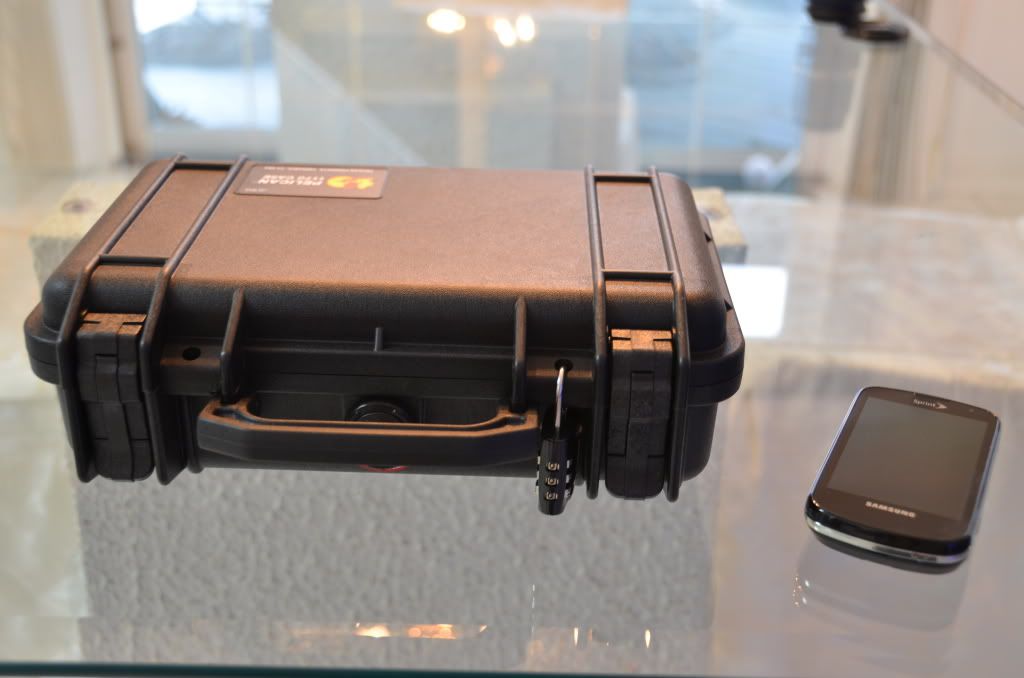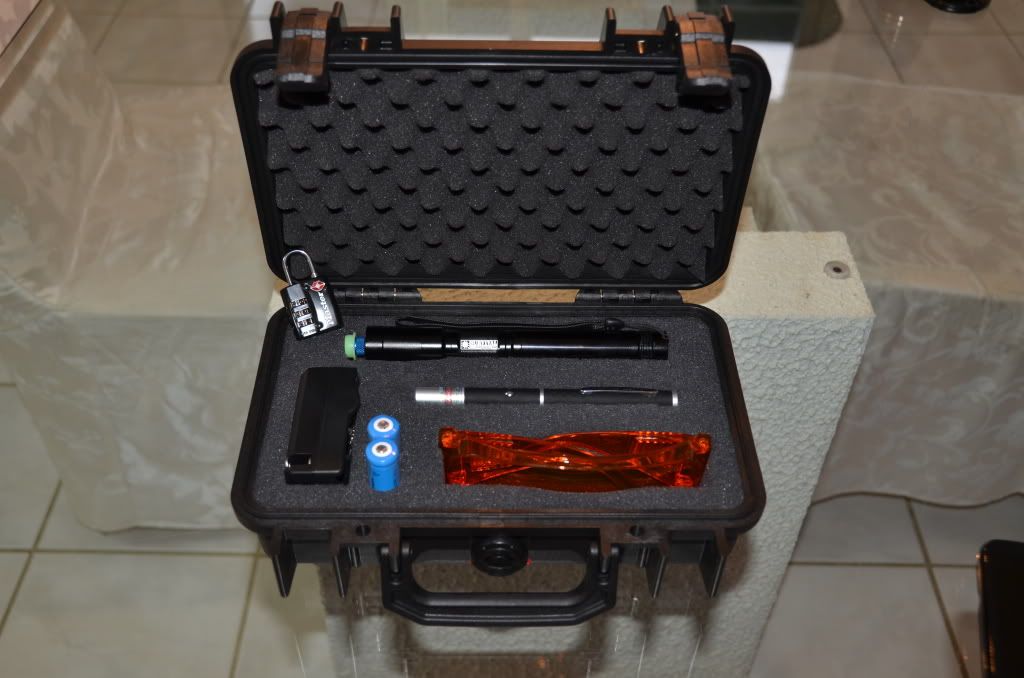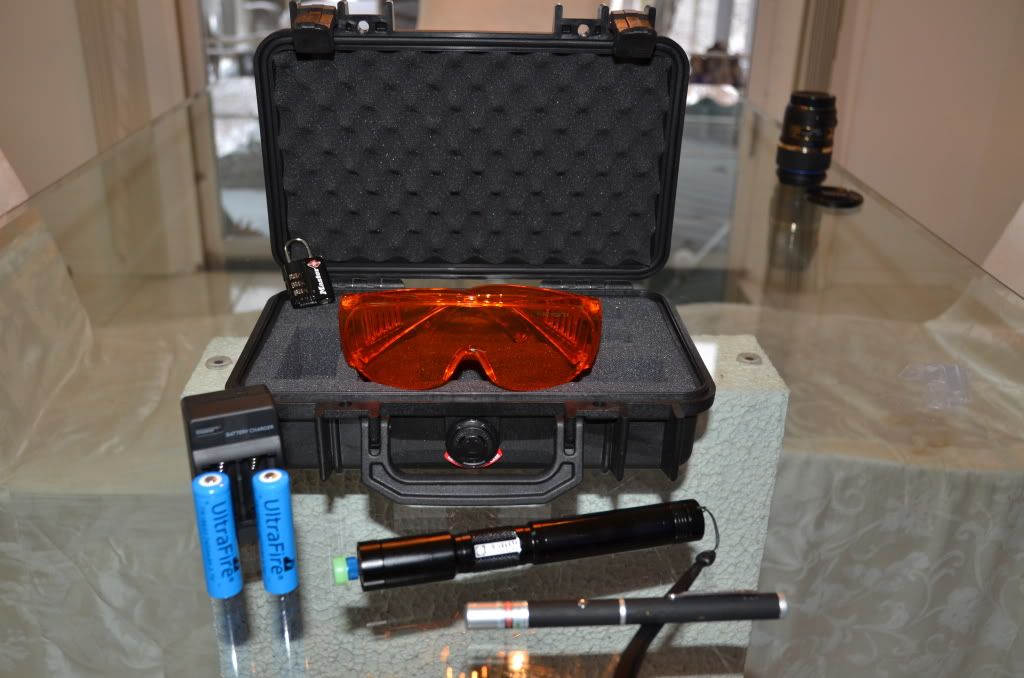I received and assembled the laser and waited for the batteries to charge (about 5 hours.) This model is 1800mW and generates a 445nm beam (beam is blue in color.) It has a 60 seconds maximum duty cycle and then requires a 120 second cooling time. I purchased a Pelican case and lock to prevent any unintentional access.
The second laser shown is a lower output 30mW laser with a 532nm beam (green.) This will be affixed to the main laser used for targeting and to test if any reflections will occur. The spectrum is important as the safety glasses block virtually all light in the 190-445nm range, making it almost impossible to see any reflections from the main laser. The green color beam of the targeting laser is easily viewable with the safety glasses on. Targeting with the low power laser is also important due to how quickly the main laser damages anything it touches. You would not want to hit a prized coral for even a second.
I've only had a time to conduct a few tests as I want to complete fabricating a shield to protect the livestock before continuing. Also, more time will be needed to fully determine the impact and to see if anything re-grows – but here is what I've observed so far…
Safety observations…This thing is scary-powerful. You have to be very careful.
- An 1800mW laser beam is both terrifying and amazing. I used a cardboard box to initially set the lens focus. The very instant the end point was focused, it began cutting through the box. In just a couple seconds the beam had completely burned through the cardboard.
- The Eagle Pair safety glasses do a great job of blocking light in the 190-540nm spectrum – All that is visible is an orange, pinpoint glow at the beam endpoint. Reflections are very difficult to see. This poses an additional risk and underscores the importance of first targeting with a low power laser (in a spectrum that can be seen while wearing the safety glasses) to test for dangerous reflections. It's also important to note that the glasses are designed to prevent against stray, reflected laser light – they are not designed to protect against a beam hitting you directly in the eye. After seeing the power of this, I shudder to think what would happen to your eye.
- Caution is advised is determining the angle at which you lase through the glass or acrylic. You have to be careful not to use the laser perfectly perpendicular to the glass/acrylic as unseen reflections will result in lasing your hand. Even the reflection is quite painful and feels like being stuck with a thousand needles. I now wear a long sleeve shirt and nitrile gloves when using the laser as another precaution.
- I have real concerns about any fish viewing the beam endpoint. Thus far, I've only used the laser in areas where no fish were present until I can fabricate a shield. I would NOT use this without a method to prevent livestock from viewing the beam end-point.
- Even after extended laser sessions with the beam in the same spot, I detected no temperature increase in either glass or acrylic. I made sure all panes were clean. As far as impact to the tank itself - I believe it to be completely safe for use from outside an aquarium.
- I've found it to be more effective if all water movement in the tank is stopped during laser sessions. The minimizes cooling keeps the targets still.
- I've ordered a second pair of safety glasses (~$50) to enable an observer to photograph and video the process. Without eye protection, I would not allow anyone (or any pet) anywhere near the room with an active laser.
Early Results
Wow… there is no doubt in my mind that this is an effective method to kill virtually ANYTHING in an aquarium. The immediate results vary based on the type of target. So far I've tried the following,
- Aiptasia – Highly effective. Within seconds, you can clearly hear a “sizzling” sound as they literally begin to boil – often following by a “pop” as they explode. They try and retreat as soon as the laser hits them. Assuming you have a clear shot at the hole – this only increased the lasers effectiveness as you're able to focus all the energy in a single spot (as opposed to lasing the fully opened Aiptasia. I will be very surprised if any of the Aiptasia targeted return. Time to total kill - <10 seconds.
- Green Star Polyps – Highly effective. Within in seconds they are toast. They burn very quickly.
- Xenia – Effective. Killing Xenia does to take longer than the Aiptasia – I'd estimate about 30 seconds. This may be due to their lighter color. It seems best to focus on the base of the polyp often resulting in a popping noise. Time will tell if they return.
- Mojano – I dont' have any Mojano in any of my tanks, but I see no reason why the results would be much different. It may take slightly longer to kill larger specimens, but the end result should be the same…death by LASER.
- Valonia – Too soon to tell. The laser quickly cuts directly though both walls of any Valonia bubble but more time will be needed to see if this actually kills the bubble.
- Miscellaneous Algaes – Too soon to tell. When lasered, virtually everything living begins to pop and smoke. It's amazing how clearly you can hear the sizzling sound. It would take a lot of time to destroy large patches of algae, but I believe it is possible.
- Cyano – Highly Effective. A quick pass makes Cyano disappear. It works although I think there are more effective means to combat Cyano.
I'll follow up with before/after photos and video once I receive a second pair of safety glasses for an observer to film and with updates as to if any of the targeted pests regrew.
[Timezone Detection]
Create Account - Join in Seconds!
Threaded View
-
11-30-2011, 09:20 AM #11

Last edited by CalmSeasQuest; 12-02-2011 at 10:54 AM. Reason: inserted initial review
The reasonable man adapts himself to the world; the unreasonable one persists in trying to adapt the world to himself. Therefore, all progress depends on the unreasonable man. - George Bernard Shaw
Similar Topics
-
Algae & Pests Pest control
By MizTanks in forum BasicsReplies: 19Last Post: 08-19-2013, 03:48 PM






 Reply With Quote
Reply With Quote
